Rostov-on-Don: problematic stadium, bought suites and 'Southern Broadway'
Matches
The capital on the River Don will host four group stage games and one 1/8 finals match (2 July).
Brazil and Switzerland will play on 17 June, Uruguay and Saudi Arabia will fight three days later, on 29 June. On 23 June, the match between Mexico and the Korean Republic will await us, and finally, the final group stage game will be on 26 June – Croatia and Iceland will be on the pitch.
Stadium
Olimp-2 was considered the best stadium in the city when Rostov-on-Don was on the list of the WC host cities. However, it didn't comply with FIFA requirements due to its capacity, which is just 14,000 people.
The construction of a new arena kicked off in 2014. The name for it was found one year later – Rostov Arena. Other, somehow funny names were offered before too, for instance, Levberdon (acronym translated as ''Don's left bank''). Indeed, the arena is on the left riverbank where places for entertainment and leisure, which we will talk about below, are concentrated.
The new stadium's capacity is standard 45,000 spectators, while the total area of Rostov Area with its adjacent territory (including big car parking) is 370,000 sq. m.
As it sometimes happens in Russia (let's remember Zenit-Arena), certain problems were found during the construction of the Rostov stadium. For example, early this February, the international commission found faults in the equipment of the stadium in Rostov-on-Don. Russian billionaire Araz Agalarov's Crocus Group erected it. According to Life, the FIFA inspectors had complaints about the pitch, there also were problems with doorways: they were too narrow to carry sponsors' equipment through.

Meanwhile, the height of ceilings in the hall for press conferences wasn't enough to put two camera platforms on the upper floor. In addition, as the inspectors noticed, the stadium lacked seats in every aisle, which would reduce 1,000 seats, and, consequently, loss of profit. Protective barriers at the stadium, including in superior zones, so-called skyboxes, impede from viewing the football pitch. Naturally, it was promised to cope with all remarks and prepare the stadium by the WC in the best way.
Stadium stop
One can reach the stadium from Platov airport by public transport: according to 2GIS, you need to take Bus 285 at Platov Airport stop, then to move Route 516 at Perekhodny Most, get off at Gorodskoy Plyazh (city beach) and get the stadium on foot. If you arrived in the main railway station of Rostov-on-Don, you need to reach the namesake stop, get in Bus 113 and then also get off at Gorodskoy Plyazh.
If you don't want to deal with transfers and other trimmings of public transport, you can take a taxi. Uber operates in Rostov (a trip from the airport to the stadium is 236 rubles by UberX), there is also Yandex.Taxi. Local services are popular: Red Taxi, White Taxi, Taxi Light, Rosy Taxi, Your Taxi offers low prices. On average, the price for a trip from the airport to the stadium fluctuates from 200 to 400 rubles. Of course, it's possible to reach the arena from the station or city centre for a lower price.

Where to stay
More than 60 unique hotels operate in Rostov, there is a variety of hostels as well as flats and rooms to rent for a night. In brief, in theory, there is a plenty of options to stay.
For instance, luxury hotels such as Radisson SAS Don Hotel, Villa de Ville or Petrovsky Mooring are full to the gills. Rooms in inexpensive hotels located in the centre (Don Quixote, Hermitage or Venice) were also bought or booked on match days. At least, it is what Booking.com says.
However, one can also find many other, more modest, economic and often remote options on the same site – hostels and guest houses will serve you.
Airbnb is another way to find a roof over your head in this peak season that offers flats and rooms to rent. For instance, as early as late February, one could find an offer of a two-bedroomed flat almost in the city centre that could accommodate five people for 11,000 rubles per night.
Sightseeing points
Ushakov Enbankment is one of the points of attraction in Rostov-on-Don. It has an amazing view on water vastness and ships and ferries circulating in the river. Almost all holidays are celebrated in the embankment. Plus, this zone has a high concentration of different cafes, restaurants, canteens and squares. Being in Rostov-on-Don, one can't help but go for a walk on Rostov Broadway – Bolshaya-Sadovaya Street. The main historical and cultural monuments, museums and leisure and administrative establishments are focused in and around it. The biggest ensemble of fountains (which will probably help guests of the Don capital to hide from heat on match days) is located on Theatre Square in front of the Rostov Academic Drama Theatre.

As for theatres, apart from the academy theatre, the city has the Maksim Gorky Academy Drama Theatre, Rostov Academy Youth Theatre, Musical Theatre and Rostov Regional Philharmonic. If you prefer another format, it can be found in experimental theatre Person in Cube, which offers its own view on how a theatre should look in the 21 st century. The theatre 18+ is the same thing.
If you came with kids, you can take them to the local zoo that has more than 400 kinds of animals, dolphinarium or water park (the latter is located not far from Rostov – in the city of Bataysk, which one can get by bus).
Those who are interested in wandering in museums, theatres, embankments and central streets can go to quite an unusual place – legendary Paramonov Warehouses. It's red brick ruins that have springs inside that make small ponds with ideally pure water. Even kids swim there without fear. Once this building was used to store wheat, which was then exported to Britain. Young Maksim Gorky worked in the warehouses at the turn of the 19 th and 20th centuries.
The Liventsov Fortress is another interesting facility. It's ruins of ancient settlements located on the territory of modern Rostov Oblast as early as the 18 th century AD. Scientists often compare this find with famous Troy. The fortress is between Liventsovka and Karatayevo khutors, on the city outskirts. One also can leave Rostov-on-Don and go to Taganrog, which is not far – a city of merchant traditions and Chekhov's places – to the Sea Azov or Starocherkassks that carefully conserves traditional of Cossack outlaws.
Where to eat
Rostov has restaurants with cuisines of different countries: from Korean to French. A Mediterranean menu can be found in Rafinad, Japanese cuisine is presented in Osaka and Silla (the latter also has Korean dishes). Yalla restaurant offers guests European, Japanese and Russian dishes, but Uzbek cuisine is the specialty.
Rostov-on-Don has a big number of establishments with Italian cuisine: Mangio, chain of Italian cafes Mamma Donna, Bellocchi restaurant and a chain of Sapore Italiano with quite reasonable prices. The concept of ''high cuisine'' in Rostov-on-Don is closely associated with Pinot Noir restaurant. The menu combines traditional French and original dishes made of local products. The Don capital also has a restaurant à la russe Onegin Dacha whose style is similar to a 19-century old mansion with a library, fireplace lounge and summer veranda sinking in the green.
Walking on the embankment, you can go to Cossack House that is full of Don colour: the interior of the establishment is in the style of a traditional Cossack hat, Cossack men and women guests on the threshold. Cuisine here is also Cossack, of course – simple, home-like full meal that anciently was cooked on the Don land. Legendary Cossack Khutor as another point of attraction on the embankment.
Tornado sports house, Kind Ale, Pinta and noisy and atmospheric Cheshki sports bar are the most famous sports bars in Rostov. Schneider Weisse Bauhaus (restaurant of the famous Bavarian Schneider family), Yesenin (place for beer savvies), Abbey Road (cult place for music and beer lovers), the chain of beer restaurants Frau Muller (the menu has traditional dishes of Russian and European cuisine with focus on German), Beer Library (characterises itself as a club for great connoisseurs of beer and literature – it has an excellent pick of books, both classics and modern-day bestsellers) are the establishments don't have a serious inclination to sport but with an accent on beer. People can watch matches and support their favourite there. Rostov-on-Don also has a chain of Harat's pub and Golodranets bar, which is called a cult place by the locals. The Rostov craft beer get-together was born there. Golodranets doesn't have cuisine, only beer.